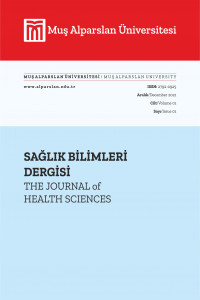Oksidatif Stres ve Karaciğer Hastalıkları
Özet: Serbest radikaller, eşleşmemiş elektronlara sahip, genellikle kararsız ve oldukça reaktif olan atom veya moleküllerdir. Reaktif Oksijen Türleri (ROT) ve Reaktif Nitrojen Türleri (RNT) olmak üzere iki çeşidi vardır. ROT ve RNT özel kimyasal özelliklerinden dolayı, lipit peroksidasyonunu başlatabilirler veya DNA iplikçiklerinin parçalanmasına neden olabilirler, aynı zamanda biyolojik membran ve dokulardaki protein yapılı molekülleri de okside ederek hasarlara neden olabilirler. Karaciğer, vücudun en büyük iç organı olmasının yanı sıra hem endokrin hem de ekzokrin bir bezdir. Karaciğer çeşitli neoplastik hastalıklar, metabolik, mikrobiyolojik ve toksik ajanlardan etkilenebilir. Alkolsüz yağlı karaciğer hastalığı (AYKH), alkol veya sekonder nedenler olmaksızın gelişen karaciğer yağlanması olarak bilinmektedir. Hasarı tamir etmeye yönelik bir iyileşme süreci olan karaciğer fibrozisi, ekstrasellüler matriks komponentlerinin artması (fibrogenezis) ile tanımlanan dinamik bir süreçtir. Siroz, karaciğer yapısının yaygın olarak rejenerasyon, hepatoselüler nekroz, nodüler oluşum ve fibroz doku ile bozularak değişmesi sonucu meydana gelen ilerleyici bir hastalıktır. Ülkemizde en fazla kronik hepatit B, hepatit C, alkolik ve hepatobiliyer hastalıklara sahip bireylerde gözlenir. Hepatosellüler karsinoma (HSK), hepatositlerden köken alan ve karaciğerin en sık rastlanan primer malign tümörüdür.
Anahtar Kelimeler:
karaciğer hastalıkları, oksidatif stres., karaciğer
___
- Akdemir B. (2012). Likopen Ve Genisteinin Tiyoasetamid İle Oluşturulan Deneysel Karaciğer Sirozunda Koruyucu Rolü. Yayınlanmış Uzmanlık Tezi, Fırat Üniversitesi, Elazığ. Apel, K. (2004). Hirt, H. Reactive oxygen species: Metabolism, oxidative stress, and signal transduction. Annu. Rev. Plant Biol. 55, 373–399.
- Barrett KE, Boitano S, Barman SM. (2012). Transport and metabolic functions of the liver. In Barrett K.E, Boitano S. Barman S.M. (eds): Ganong’s review of medical physiology, ed 24. New York: McGraw-Hill. Catalá A. (2006). An overview of lipid peroxidation with emphasis in outer segments of photoreceptors and the chemiluminescence assay. Int J Biochem Cell Biol. 38: 1482-1495.
- Chen H, Tappel A.L. (1996). Protection of multiple antioxidants against heme protein oxidation and lipid peroxidation induced by CBrCl3 in liver, lung, kidney, heart, and spleen. J. Agric. Food Chem. 44(3); 854-858.
- Christopher P. Day, Oliver F.V JAMES (1998). Steatohepatitis: A tale of ''two'' hits? AGA Volume 114, Issue 4, P-842-845.
- Edmison J. Mc Cullough A.J. (2007). Pathogenesis of non-alcoholic stea-tohepatitis: human data. Clinics in Liver Disease. 11, 75–104.
- Fatiha Nassir and Jamal A. (2014). Ibdah Role of Mitochondria in Nonalcoholic Fatty Liver Disease. 15(5): 8713–8742.
- Floyd RA. (1992). DNA damage and repair in Oxidative Damage and Repair. Davies KJA. Ed. Pergamon Press. 32;175-180.
- Gupta RK, Patel AK, Shah N, et al. (2014). Oxidative stress and antioxidants in disease and cancer: a review. Asian Pac J Cancer Prev;15: 4405-4409.
- Gutierrez-Reyes G, Gutierrez-Ruiz MC, Kershenobich D. (2007). Liver Fibrosis and Chronic Viral Hepatitis. Arch Med Res. 38: 644-51.
- Hall, J.E. (2010). Guyton and Hall textbook of medical physiology. Elsevier Health Sciences.: p.886-889.
- Hardie LJ, Briggs JA, Davidson LA, et al. (2000). The effect of hOGG1 and glutathione peroxidase I genotypes and 3p chromosomal loss on 8-hydroxydeoxyguanosine levels in lung cancer. Carcinogenesis.21: 167- 172.
- Hernandez-Gea V, Friedman SL. (2011). Pathogenesis of liver fibrosis. Annu Rev Pathol Mech; 6: 425-456,
- Hu JJ, Dubin N, Kurland D et al. (1995). The effects of hydrogen peroxide on DNA repair activities. Mutat Res;336:193-201. 27
- Jou J. Choi S.S. Diehl A.M. (2008). Mechanisms of disease progression in nonalcoholic fatty liver disease. Seminars in Liver Disease. 28, 370–379.
- Mc Cormick PA. (2011). Hepatic Cirrhosis. In: Sherlock’s Diseases of the Liver and Biliary System, 12th Edition. doi:10.1002/9781444341294.ch7 Moore, K.T. Persaud, and M. Torchia, (2002). İnsan embriyolojisi. Eds. Yıldırım, M., Okar, İ., Dalçık, H., Nobel Tıp Kitabevleri: 492-498.
- Moore, K.L. A.F. Dalley, and A.M. Agur, (2013).Clinically Oriented Anatomy. Lippincott Williams & Wilkins.268-272.
- Paradis V, Dargere D, Vidaud M, et al. (1999). Expression of connective tissue growth factor in experimental rat and human liver fibrosis. Hepatology; 30: 968-976.
- Puche JE, Saiman Y, Friedman SL. (2013). Hepatic stellate cells and liver fibrosis. Compr Physiol; 3: 1473-1492.
- Rao RS, Moller IM. (2011). Pattern of occurrence and occupancy of carbonylation sites in proteins. Proteomics;11: 4166-4173
- Ross, M.H. G.I. Kaye, and W. Pawlina, (2014). Histology: A Text and Atlas: With Cell and Molecular Biology. Lippincott Williams & Wilkins. 628-643.
- S. Mittal and H. B. El-Serag, (2013). Epidemiology of hepatocellular carcinoma: consider the population. Journal of Clinical Gastroenterology,vol. 47, pp. S2–S6.
- Sıes H. (1991). Oxidative stress: from basic research to clinical application. Am J Med. 91:31-38.
- Singal AK, Hasanin M, Kaif M, et al. (2016). Nonalcoholic steatohepatitis is the most rapidly growing indication for simultaneous liver kidney transplantation in the United States. Transplantation;100:607–612
- Thorgeirsson, S.S. and J.W. Grisham. (2002). Molecular pathogenesis of human hepatocellular carcinoma. Nat Genet. 31:339-46.
- Yıldız E. (2002) Hepatocellular Carcınoma Vıral Etıology And Cellular Mechanısms. Doctor Of Phılosophy The Instıtute Of Engıneerıng And Scıence. The Department Of Molecular Bıology And Genetıcs, Bilkent Unıversıty, Ankara.
- Younossi ZM, Stepanova M, Afendy M, et al. (2011). Changes in the prevalence of the most common causes of chronic liver diseases in the united states from 1988 to 2008. Clin Gastroenterol Hepatol;9: 524-530.
- Zakim D, Boyer TD. (2002). Hepatology: A Textbook of Liver Disease. New York: Saunders. 395-409.
- Zhanpeng W. Et al. (2016). Review Article Oxidative Stress and Liver Cancer: Etiology and Therapeutic Targets Oxidative Medicine and Cellular Longevity Volume, Article ID 7891574, 10 pages
- Başlangıç: 2021
- Yayıncı: Muş Alparslan Üniversitesi
Sayıdaki Diğer Makaleler
Oksidatif Stres ve Karaciğer Hastalıkları
Büro Çalışanlarında Sıklıkla Görülen Kas ve İskelet Sistem Hastalıkları ve Önleme Yolları
Cengiz TAŞKAYA, Buket BÜYÜKTURAN
Hemşirelikte Ortak Dil ve Sınıflandırma Sistemleri
Şeydanur BAHŞİ, Hanifi KÖRKOCA
